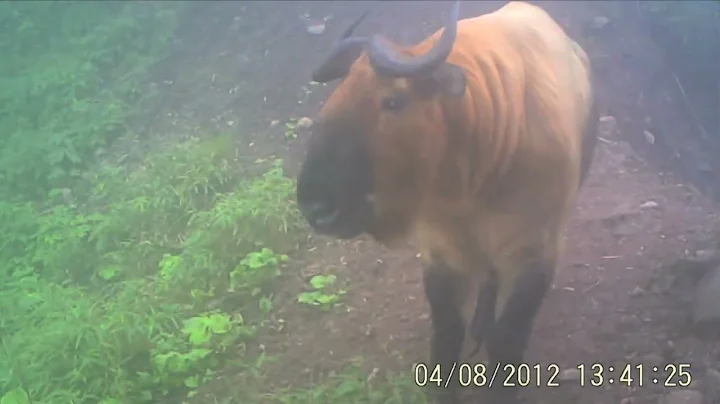On July 1, 2022, " China Daily "
published
"The Daqingshan Elk Herd in Inner Mongolia Reproduced Successfully"
The translation is as follows
↓↓↓

Dozens of elk thrive in the Daqingshan National Nature Reserve in Inner Mongolia growing up. In September 2021, 27 elk from the Beijing Elk Ecological Experiment Center and Jiangsu Dafeng Elk National Nature Reserve were successfully released into the Daqingshan National Nature Reserve in Inner Mongolia. In April this year, 9 elk were born one after another. Cub.
Every morning, Ma Haibo and his colleagues appear on the slopes of the Daqingshan National Nature Reserve in Inner Mongolia. Carrying binoculars and drones, they are performing an important mission - tracking and documenting the elk population's abundance, diet and mating, as well as collecting elk scat for analysis.
In September 2021, 27 elk from the Beijing Elk Ecological Experiment Center and Jiangsu Dafeng Elk National Nature Reserve were successfully released to the Daqingshan National Nature Reserve in Inner Mongolia.

Information picture
In April this year, 9 elk calves were born successfully. Since the mating season of elk is from June to August, Ma Haibo and his colleagues still need to follow up and observe whether the female elk can successfully conceive.
Elk mainly feed on grass, and will also supplement aquatic plants in summer, usually looking for food near water sources.
In 2019, the National Forestry and Grassland Administration launched the elk protection plan to expand the elk’s habitat. After experts came to the Daqingshan National Nature Reserve for inspection, they selected a place with sufficient food and water sources to release the elk. Scientific researchers have been using Beidou satellite positioning collars to closely track and monitor the health status of wild elk populations in real time.

Information picture
Elk was once active in the Yellow River and the middle and lower reaches of the Yangtze River. It is also known as the "four different animals", with a head like a horse, antlers like a deer, hooves like a cow, and a tail like a donkey. Elk's body hair is rust-colored in summer and gray in winter. The elk has a mane on its neck, a black vertical stripe on the back of its neck, well-developed hanging hooves, and makes a loud sound when walking.
htmlIn the early 120th century, due to rampant hunting and habitat loss, elk became extinct in mainland China. In the 1980s, the elk returned to China from Britain. After more than 30 years of hard work, China's elk population has exceeded 10,000, of which 4,400 are in the wild. These elk mainly come from three major elk reserves: Nanhaizi in Beijing, Dafeng in Jiangsu and Shishou in Hubei.
It is a new challenge for Ma Haibo and his colleagues to keep track of the dynamics and health status of elk in Daqingshan Nature Reserve.

Information pictures
Ma Haibo will read books related to elk and call elk experts to ask questions. According to his observation, the elk populations from Nanhaizi in Beijing and Dafeng in Jiangsu get along very well and gradually merge into a new population.
Ma Haibo also has an important responsibility at the nature reserve management station, which is to record data related to the ecological resources of Daqingshan Nature Reserve. Due to the country's ecological protection policy and sufficient rainfall in recent years, the vegetation coverage of the reserve has increased. The numbers of wild animals, such as antelopes and roe deer, are also growing.
"Elk originally lived in wetlands or swamps. This is their first time coming to cold mountainous areas, and the winter temperature in the reserve can reach as low as minus 30 degrees Celsius," Haoren Taben, deputy director of the Daqingshan National Nature Reserve Administration in Inner Mongolia explain. "Our staff built a winter warming shelter for the elk, but they have never been there. Elk have thick fur to keep out the cold. The key now is to see whether the cubs can adapt to the new environment."

Information picture
Beijing Elk Guo Qingyun, an associate researcher at the Ecological Experiment Center, said: "The current increasing number of elk and the limited habitat in the country are problems we are facing." So far, the center has transported 598 elk to protected areas across China.
"The birth of the elk calf shows that the Daqingshan Nature Reserve is a suitable habitat. This will help us explore more potential habitats suitable for elk in the future. However, we still need time to prove whether a wild elk population has been successfully established there. species," she said.
"Male elk will compete for mating rights. The polygamous characteristics of elk also mean that elk have a higher possibility of inbreeding, which may lead to genetic defects and lower disease resistance. This time two from Beijing and Jiangsu The local elk established exchanges for the first time, increasing the genetic diversity of the elk population," Guo Qingyun said.
Source: China Daily





















